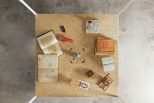Sou Fujimoto, a Japanese architect was a child who enjoyed playing in the forest, near the house and was…

Research in the field of tensile structures, temporary projects made with cheap materials, such as cardboard and bamboo. At a time when the concept of sustainability and materials become the best practices of design, the Nobel for architecture goes to the Japanese Shigeru Ban.
 The architect who has been designing the study of Arata Isozaki, won the Pritzker Prize. “Shigeru Ban’s commitment to humanitarian causes through his disaster relief work is an example for all. Innovation is not limited by building type and compassion is not limited by budget. Shigeru has made our world a better place”, said the jury.
The architect who has been designing the study of Arata Isozaki, won the Pritzker Prize. “Shigeru Ban’s commitment to humanitarian causes through his disaster relief work is an example for all. Innovation is not limited by building type and compassion is not limited by budget. Shigeru has made our world a better place”, said the jury.
Among the most interesting projects, there are the projects in critical conditions and emergency. As the small houses of 16 square meters designed with cardboard tubes and boxes for beer bottles filled with sand for the Kobe earthquake in 1995.
 He works with unconventional materials, including paper and recycled fibre composite of paper and plastic. Interesting examples are the paper House in Tokyo, the Curtain Wall House, and the Centre Pompidou Metz to Paris or the Transitional Cathedral in New Zealand.
He works with unconventional materials, including paper and recycled fibre composite of paper and plastic. Interesting examples are the paper House in Tokyo, the Curtain Wall House, and the Centre Pompidou Metz to Paris or the Transitional Cathedral in New Zealand.
 “Shigeru Ban is able to see in standard components and common materials, such as paper tubes, packing materials or containers for transport, new opportunities for use. For him, sustainability is not a concept attributed to the building completed, but it is intrinsic to architecture. His works shall endeavour to use appropriate products and systems, compatible with the environment and the specific context, using renewable and locally available materials “.
“Shigeru Ban is able to see in standard components and common materials, such as paper tubes, packing materials or containers for transport, new opportunities for use. For him, sustainability is not a concept attributed to the building completed, but it is intrinsic to architecture. His works shall endeavour to use appropriate products and systems, compatible with the environment and the specific context, using renewable and locally available materials “.





